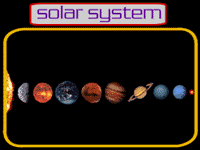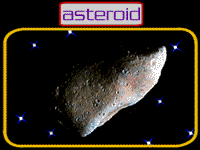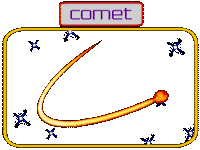- Objective:
To learn about the solar system.
- New Concepts:
-
solar system, planet, asteroid, comet.
|
-
We live on Earth -- where we have day and night and four seasons in the year. We have the Sun that grows
our food and keeps us warm. We breathe the air that surrounds us. The reason we have all this is because
Earth is a planet -- a member of the solar system.
|

Fig.1 The solar system. From left are the Sun, Mercury, Venus, Earth, Mars, Jupiter, Saturn, Uranus,
Neptune and Pluto, in their order from the Sun. Asteroids and comets are not presented in the figure. In
reality, the planets are not as equal in size and distance from each other as they are in this picture.
|
- Solar System
-
The solar system is like a family made up of objects in the sky. The Sun forms the centre of the solar
system, and surrounding it are all the other family members: planets, their moons, asteroids and comets.
The Sunís gravitational force holds the solar system together. It also provides us with light and heat that
are powered by nuclear reactions burning constantly inside the Sun. Without this light and heat, there
would be no life on Earth -- so the Sun is very important to us.
|
Check out the Sun and its family of planets...
|
- Planets and their Moons
-
The solar system contains nine planets. Mercury is closest to the Sun, followed by Venus, Earth, Mars,
Jupiter, Saturn, Uranus, Neptune and Pluto. Each planet is different, as you will see when you visit them,
below. Jupiter is the solar systemís largest planet -- larger than all the other planets put together. Pluto
is the planet farthest from the sun, and at one-tenth the size of the Earth, it is the solar systemís smallest
planet.
Our closest neighbor, the Moon, is about 400,000 km away. It is our natural satellite, taking nearly a
month to orbit around us. Other planets in the solar system also have their own moons. Jupiter, for
example, has 16 moons and Saturn has over 20.
|

Fig.2 Asteroid Gaspra. An irregular rocky chunk measuring 19x12x11 km.
|
- Asteroids
-
Besides the nine planets, there are many minor planets orbiting the Sun. They are called
asteroids, which means "starlike" in Latin. Asteroids are believed to be rocky fragments that
never formed into planets, and most of them move in a belt between Mars and Jupiter. The largest
asteroid has a diameter of about 1,000 km across -- about the width of France. The little ones can be as
small as about 20 meters across.
|

|
- Comets
-
Comets are another part of the solar system family. They are made of ice and dust, like dirty
snowballs, and they spend most of their time traveling in remote regions of the solar system, far away
from the Sun. When comets move close to the Sun a spectacular sight occurs. As a comet moves towards the Sun, its ice is turned to vapor by the Sunís heat.
This causes the comet to give off gas and dust that form a trailing tail behind it. Sometimes the cometís
bright head and long tail look like a glistening dagger poised against twinkling stars.
|
Figure Credits:
Fig.1, Z. H. Zhou; Fig.2, NASA, the Galileo Project.
|

